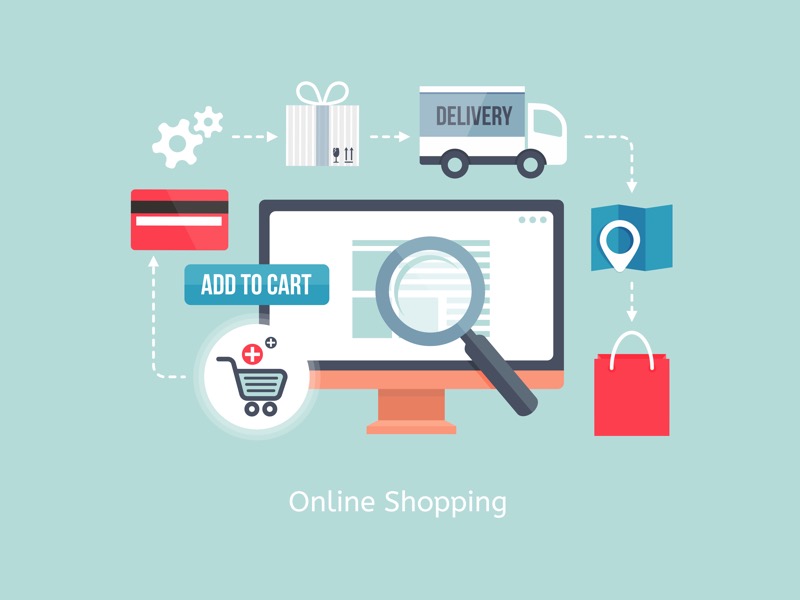In the ever-evolving landscape of commerce, staying ahead of emerging trends is essential for retailers and advertisers for remaining competitive. As we approach the second half of 2023, the realm of commerce media is experiencing a profound transformation driven by changing consumer expectations, technological advancements, and a shifting advertising paradigm. From seamless shopping experiences to the rise of sustainability, these ten market-altering trends from Criteo are reshaping the future of commerce media.
1. Consumers demand a seamless shopping experience as e-commerce booms

In the midst of the booming e-commerce industry, consumer expectations for a seamless shopping experience have reached new heights. Whether shopping online or in-store, modern consumers demand a frictionless journey that transcends traditional boundaries. They seek convenience, efficiency, and personalized interactions at every touchpoint with retailers.
To meet these evolving demands, retailers must recognize the importance of integrating their digital and physical channels. A siloed approach is no longer sufficient in a world where customers seamlessly transition between online browsing and in-store visits. By breaking down these barriers and providing a cohesive shopping experience, retailers can enhance customer satisfaction and gain a competitive edge.
Achieving a seamless shopping experience requires a holistic approach that involves streamlining inventory management, optimizing product information across channels, and implementing robust omnichannel strategies. Retailers must invest in technologies that facilitate unified customer experiences, such as click-and-collect options, real-time inventory visibility, and personalized recommendations based on online and offline interactions. By bridging the gap between digital and physical realms, retailers can create a seamless journey that caters to the evolving needs and expectations of today’s consumers.
2. Retailer data redefines programmatic advertising

In today’s digital age, data has become the currency of the advertising world, and retailers possess a treasure trove of valuable information: their first-party data. This data, collected directly from their customers, is redefining the landscape of programmatic advertising, which relies on automated systems to deliver targeted ads to specific audiences.
First-party data refers to the information collected by retailers from their own interactions with customers, such as website visits, purchase history, loyalty programs, and customer preferences. Unlike third-party data, which is obtained from external sources, first-party data is unique to each retailer and offers unparalleled insights into their customer base.
By leveraging their first-party, closed-loop data sets, retailers can gain a deep understanding of consumer behavior and preferences. This data provides valuable insights into customers’ purchase patterns, interests, demographics, and even their engagement with marketing campaigns. Armed with this knowledge, advertisers can create highly targeted and personalized advertising campaigns that resonate with their intended audience.
One of the key advantages of using first-party data in programmatic advertising is the ability to reach customers at different stages of the purchase journey. For example, if a retailer’s data indicates that a customer has previously browsed a particular product category but hasn’t made a purchase, advertisers can deliver targeted ads specifically designed to encourage them to complete the purchase. This level of personalization and relevance significantly increases the effectiveness of advertising campaigns.
Moreover, retailers’ first-party data is considered more reliable and accurate compared to third-party data sources, which can be prone to inaccuracies and limited in scope. Since retailers have a direct relationship with their customers, the data they collect is more trustworthy and reflective of actual consumer behavior.
The availability of robust first-party data also allows retailers to optimize their advertising spend. By understanding which customer segments are most likely to respond positively to their ads, retailers can allocate their budget more efficiently, focusing on the audiences that are most likely to convert. This data-driven approach enhances the return on investment (ROI) of advertising campaigns and helps retailers make informed decisions about their marketing strategies.
3. A combined focus on brand and performance is essential

In the dynamic landscape of retail media, there is a growing recognition among advertisers of the need for a combined focus on brand-building and performance-driven strategies. Traditionally, brands have emphasized the lower end of the purchase funnel, aiming to drive immediate conversions. However, as consumer behavior evolves, advertisers are realizing the importance of capturing customers earlier in the purchase journey to build brand awareness, loyalty, and consideration.
Retail media presents a compelling platform for achieving this combined brand and performance focus. With its highly targeted and engaged audiences, advertisers can reach consumers at various touchpoints along their shopping journey, from initial product discovery to final purchase decisions. The insightful data available through retail media platforms allows brands to understand consumer behavior, preferences, and purchase patterns, enabling them to create more relevant and impactful advertising campaigns.
The convergence of brand and performance budgets reflects a strategic shift in advertisers’ approach. By investing in both brand-building and performance-driven tactics, brands can establish a strong presence in the market, differentiate themselves from competitors, and cultivate long-term customer relationships. This integrated approach acknowledges the interconnectedness of brand equity and measurable outcomes, recognizing that a well-rounded strategy that encompasses both brand and performance goals is essential for sustained success in the competitive retail landscape.
4. Commerce media experts are the new talent

As the retail and media industries continue to intersect and evolve, the demand for specialized talent in commerce media is on the rise. In 2023, comprehensive campaign management is more crucial than ever, as media campaigns require granular reporting and tactics for optimal performance. This shift in accountability has created a need for a new breed of professionals who possess a unique skill set and understanding of both the retail and media landscapes.
Commerce media experts are bilingual specialists who bridge the gap between retail and media. They possess a deep understanding of the retail industry, including consumer behavior, market trends, and the intricacies of commerce models. At the same time, they are well-versed in media strategies, digital advertising platforms, and data analysis. This expertise allows them to navigate the complexities of the evolving retail landscape and provide strategic guidance to clients.
Commerce media experts play a pivotal role in helping clients optimize their advertising campaigns, streamline operations, and deliver tangible results. They possess the ability to leverage data insights, identify target audiences, and create tailored strategies that align with business goals. By understanding the nuances of both retail and media, these specialists can develop comprehensive campaign management plans that integrate marketing efforts across various channels, ensuring cohesive and impactful messaging that drives conversions and business growth.
5. Media budgets shift to measurable channels

Retailers are recognizing the need to adapt their strategies and are offering innovative solutions to support offsite advertising. This shift is driven by the increasing demand for measurable channels that provide clear insights into the return on investment (ROI) of advertising campaigns.
Media buyers play a crucial role in this transition, as they must adjust their budget allocation strategies to align with the changing dynamics of the industry. The focus is shifting from traditional channels that have limited tracking and measurement capabilities to channels that offer more robust analytics and reporting. By investing in measurable channels, media buyers can gain valuable insights into the effectiveness of their campaigns, enabling them to optimize their spending and allocate resources to channels that deliver the best results.
The migration of media budgets to new channels is an ongoing process that reflects the industry’s recognition of the importance of ROI-driven spending. Retailers are exploring diverse options, such as digital platforms, social media advertising, influencer marketing, and programmatic advertising, which provide more precise tracking and analytics capabilities. This shift not only allows retailers to better understand the impact of their advertising efforts but also empowers them to make data-driven decisions, ensuring that their budgets are allocated strategically to achieve the highest possible returns.
6. Offsite advertising opens new revenue opportunities

The expansion of offsite advertising presents retailers with exciting new revenue opportunities. By extending their reach beyond their own websites and venturing into the open web, retailers can monetize their digital assets in various forms, such as sponsored ads, display ads, and video content. This strategic move allows retailers to engage with audiences outside of their immediate customer base, tapping into unique segments and expanding their brand visibility.
One significant advantage of offsite advertising is the ability to employ upper-funnel tactics without sacrificing lower-funnel metrics. While lower-funnel metrics focus on immediate conversions and direct sales, upper-funnel tactics aim to generate brand awareness, consideration, and engagement. By leveraging offsite advertising, retailers can reach potential customers who may be earlier in the purchase journey, capturing their attention and driving them toward eventual conversions. This holistic approach to advertising enables retailers to establish a strong brand presence while still maintaining their focus on measurable outcomes.
Furthermore, offsite advertising on the open web provides retailers with closed-loop measurement capabilities. This means that retailers can track the entire customer journey, from initial engagement with the offsite ad to the final conversion on their own website. This closed-loop measurement enables retailers to gain valuable insights into the effectiveness of their offsite advertising efforts, optimizing their campaigns and driving higher returns on investment.
7. Generative AI transforms marketing and retail playbooks

The emergence of generative AI technology has the potential to revolutionize the marketing and retail landscape. Generative AI tools, specifically designed for the retail industry, are expected to play a significant role in transforming various aspects of advertising, workflow management, and customer service. By leveraging generative AI, retailers and brands can deliver personalized shopping experiences, optimize their advertising campaigns, and streamline their operational processes.
Generative AI tools offer the capability to create personalized and dynamic content at scale. By analyzing vast amounts of data, including customer preferences, behaviors, and purchase history, these tools can generate tailored marketing content that resonates with individual customers. This level of personalization not only enhances the customer experience but also drives higher engagement and conversion rates. Additionally, generative AI can optimize ad campaigns by automatically testing and refining various creative elements, such as headlines, images, and calls-to-action, based on real-time feedback and performance data.
8. Gen Z drives conscious consumerism

Gen Z, the demographic cohort born roughly between the late 1990s and early 2010s, is emerging as a force to be reckoned with in the consumer market. This generation holds substantial spending power and possesses unique values that are shaping their consumption patterns. Advertisers have recognized the significance of tapping into these values, which include sustainability, affordability, diversity, and inclusion, in order to effectively engage with Gen Z consumers.
In 2023, marketers are embracing a variety of tactics and platforms to efficiently reach Gen Z and create advertisements that align with their values. One key aspect of reaching this generation is through digital platforms and social media channels, as Gen Z is known for its high level of digital fluency and online engagement. Marketers are leveraging influencer marketing, social media campaigns, and user-generated content to connect with Gen Z and communicate their brand values in an authentic and relatable manner.
Furthermore, conscious consumerism is a driving factor among Gen Z, as they actively seek out products and brands that align with their values and contribute positively to society and the environment. Advertisers are responding by highlighting sustainable practices, ethical sourcing, and social responsibility initiatives in their ad campaigns. By showcasing their commitment to these values, marketers can capture the attention and loyalty of Gen Z consumers who are passionate about making conscious choices in their purchasing decisions.
9. Product SKU precision drives outcome-based media

Product SKU-level reporting and targeting provide advertisers with a more detailed understanding of consumer preferences and behaviors. By analyzing data related to specific product SKUs and stores, advertisers can gain valuable insights into what drives consumer interest and purchasing decisions. This level of granularity allows them to optimize their advertising strategies, tailoring their messaging and offers to align with the specific preferences of their target audience. With the end of third-party cookies, product SKU precision becomes even more crucial as it provides a reliable alternative for advertisers to deliver personalized and relevant advertisements to consumers.
As the focus shifts to advertising outcomes, product SKU-level reporting and targeting are set to become instrumental in measuring and optimizing campaign success. Advertisers can track the performance of individual SKUs and stores, understanding which products resonate with consumers and which locations drive the highest engagement and conversions. This data-driven approach enables advertisers to make informed decisions, allocating their resources effectively and optimizing their advertising efforts to achieve desired outcomes. By leveraging product SKU precision, advertisers can unlock valuable insights and drive more effective and efficient advertising campaigns.
10. Sustainability drives the future of advertising

Sustainability has become a prominent force shaping the future of advertising. Media buyers and owners are recognizing the importance of integrating eco-conscious practices into their operations. This shift towards sustainability encompasses various aspects of the advertising industry, including campaign strategies, technology adoption, and operational practices.
Media buyers and owners are actively prioritizing eco-friendly initiatives, such as adopting carbon-neutral campaigns. This involves offsetting the carbon emissions generated by advertising activities through the support of renewable energy projects or carbon reduction projects. By making conscious choices to reduce their carbon footprint, advertisers can align their messaging with the growing consumer demand for environmentally responsible practices.
The full version of the 2023 Commerce Media Market-Altering Trends report is available on the Criteo website.

